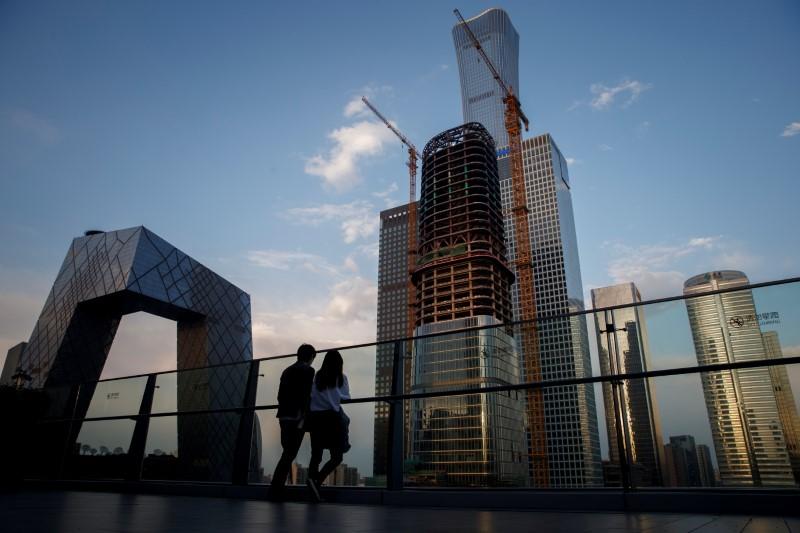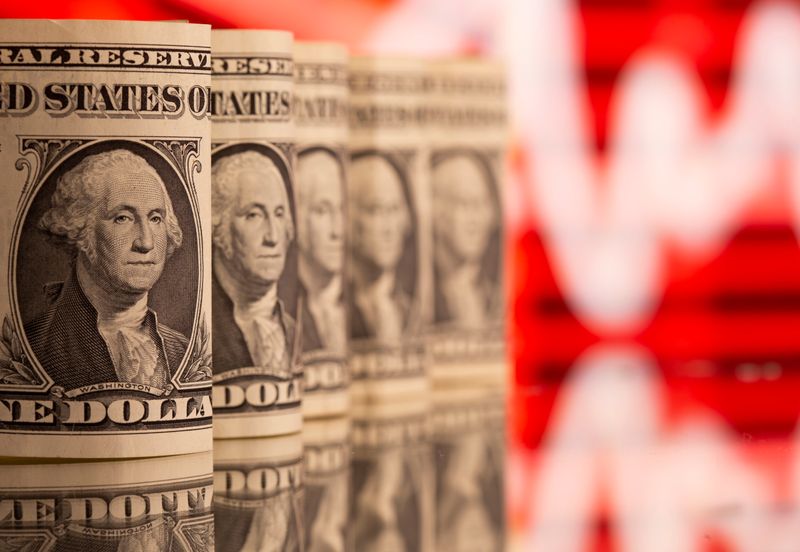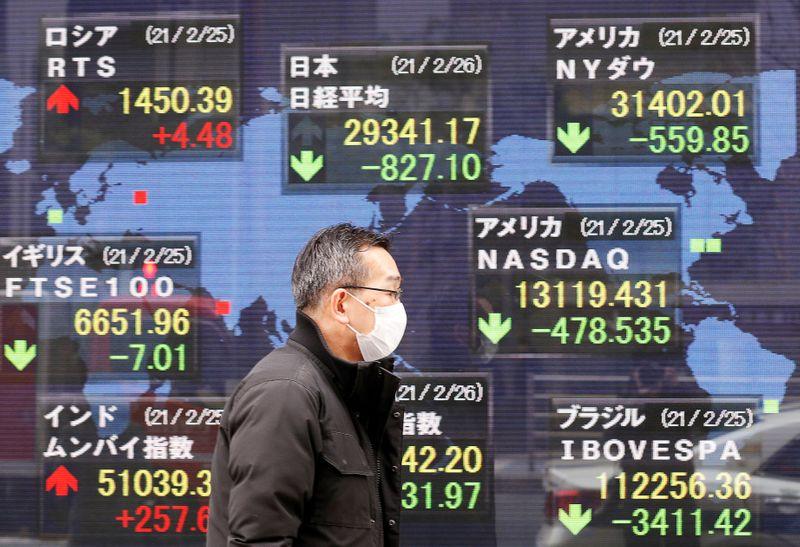WORLDWIDE: HEADLINES
China’s services sector grows at slowest rate in 10 months in February: Caixin PMI

BEIJING – China’s services sector activity grew at its slowest pace in 10 months in February as firms struggled with sluggish demand and high costs, a private sector survey showed on Wednesday, prompting them to cut jobs.
The Caixin/Markit services Purchasing Managers’ Index (PMI) fell to 51.5, the lowest since April, from 52.0 in January but remained above the 50-mark that separates growth from contraction on a monthly basis.
A sub-index for employment stood at 47.9, slipping into contraction after six months of growth, as businesses laid off workers, the survey showed. New export business also shrank after expanding for three months.
The loss of momentum came as China faced coronavirus flare-ups at the start of the year, while overseas demand continued to be hit by the COVID-19 pandemic. The findings were largely in line with an official survey released on Sunday.
“The momentum of post-epidemic services recovery further weakened,” said Wang Zhe, senior economist at Caixin Insight Group, in a statement accompanying the data release.
“Service providers cut staff to reduce costs as weakened market sentiment had a knock-on effect on the job market.”
The services sector, which had been slower to recover initially from the pandemic than the industrial sector, is more vulnerable to social distancing restrictions.
Domestic COVID-19 cases have however been stamped out in China since early February and analysts expect a strong rebound in full-year growth.
Full coverage: REUTERS
Australian economy storms ahead as COVID recovery turns ‘V-shaped’

SYDNEY – Australia’s economy expanded at a much faster-than-expected pace in the final quarter of last year and all signs are that 2021 has started on a firm footing too helped by massive monetary and fiscal stimulus.
The economy accelerated 3.1% in the three months to December, data from the Australian Bureau of Statistics (ABS) showed. Economists in a Reuters poll forecast a 2.5% rise following an upwardly revised 3.4% gain in the third quarter.
Despite the best ever back-to-back quarters of growth, annual output still shrank 1.1%, underscoring the havoc wreaked by the coronavirus pandemic and suggesting policy support will still be needed for the A$2 trillion ($1.57 trillion) economy.
The Australian dollar rose about 10 pips to a day’s high of $0.7836 after the data while bond futures nudged lower with the three-year contract implying an yield of around 0.3% compared with the official cash rate of 0.1%.
“The ‘V-shaped’ nature of the recovery is everywhere to see – economic growth, the job market, retail spending and the housing market,” said Craig James, Sydney-based chief economist at CommSec.
“But the job is not done. The economy is still around 1% smaller than a year ago. Unemployment is still too high; inflation and wage growth are still too low.”
James expects the economy to rebound 4.2% in 2021, led by stimulus and support measures.
Consumers are expected to drive growth in the current quarter with data on credit and debit card spending by major banks as well as official figures on retail sales, employment and building activity all staying strong.
Full coverage: REUTERS
WORLDWIDE: FINANCE / MARKETS
Dollar on defensive as risk sentiment recovers amid retreat in U.S. yields; Aussie gains

TOKYO – The safe-haven U.S. dollar remained broadly weaker on Wednesday as Treasury yields continued to retreat, restoring some calm to global markets and reigniting demand for riskier assets.
Commodity-linked currencies including the Australian dollar and the Norwegian krone held on to sizeable two-day advances.
The lower U.S. yields also sapped some of the dollar’s allure among fellow low-yielding currencies, with the yen and Swiss franc bouncing off multi-month lows.
Bonds have been at the center of a storm in financial markets in recent weeks, following a dramatic jump in yields globally – but led by Treasuries – in defiance of central bankers’ insistence on patience in normalizing monetary policy as economies recover from the COVID-19 pandemic. Global stocks were knocked from near record highs, and commodities prices wobbled.
Fiscal stimulus has fueled market expectations for a rapid recovery, with President Joe Biden close to passing a $1.9 trillion spending package.
An index of the dollar against six of its major peers was little changed early in the Asian session Wednesday, after dropping back from a nearly one-month high overnight.
The Aussie rose 0.1% to $0.7824, following gains of about 0.7% the previous two days. The currency got additional support from gross domestic product data that topped analyst forecasts.
The krone traded mostly flat after advancing about 1% in each of the past two sessions.
“Risk sentiment dynamics are the key driver of currencies in general right now,” said Shinichiro Kadota, senior currency strategist at Barclays Capital in Tokyo.
“Equity market reaction will be one of the key determinants of the impact of this move in global rates on FX markets.” The lull in volatility could prove fleeting if an improving U.S. economy reignites bond selling, with closely watched monthly payroll figures are due on Friday.
Full coverage: REUTERS
Oil slips on concerns that OPEC+ may be set to pump up supply

MELBOURNE – Oil prices were down in early trade on Wednesday, extending several days of losses, amid uncertainty over how much supply producing countries will push to restore to the market at a meeting this week while the coronavirus pandemic persists.
U.S. West Texas Intermediate (WTI) crude futures fell 18 cents, or 0.3%, to $59.57 a barrel by 0122 GMT, down 6% since Feb. 25, when they hit their highest close since May 2019.
Brent crude futures dipped 7 cents, or 0.1%, to $62.63 a barrel, down 7% from a 13-month high hit last week.
The Organization of the Petroleum Exporting Countries (OPEC) and allies, together called OPEC+, are set to meet on Thursday, at a time when they are generally positive on the oil market outlook compared with a year ago when they slashed supply to boost prices.
OPEC+ sources last week said an output increase of 500,000 barrels per day (bpd) looked possible without building inventories. Saudi Arabia’s voluntary cut of 1 million bpd is due to end in April, but it is unclear whether it will restore all of that supply right away.
“The days of GDP and oil demand figures being in the red because of the pandemic-induced shock appear to be behind us,” OPEC Secretary General Mohammad Barkindo said on Tuesday, speaking ahead of a meeting of OPEC+’s Joint Technical Committee (JTC).
However, a JTC document seen by Reuters cited continued uncertainties in physical markets and risks of the coronavirus pandemic persisting with COVID-19 mutations.
“The question the group must answer this week is whether the rebound in demand is strong enough to sustain an increase in output,” ANZ analysts said in a note.
Reinforcing concerns of potential oversupply, the American Petroleum Institute industry group reported U.S. crude stocks rose by 7.4 million barrels in the week to Feb. 26, in stark contrast to analysts’ estimates for a draw of 928,000 barrels. [API/S]
“The unexpectedly large crude inventories build hit at a worrying time for oil bulls,” said Stephen Innes, global market strategist at Axi.
Full coverage: REUTERS
Asian shares nudge higher in defensive trade, dollar soft

NEW YORK – Asian shares edged higher on Wednesday as investors shrugged off concerns that stocks may have rallied too far too fast in the past year, and focused instead on optimism that more imminent U.S. stimulus will energize the global economic recovery.
Australian shares gained 0.45% in early trade while E-mini S&P futures were up 0.2%.
Wall Street had retreated overnight after beginning March with a bang, with the S&P 500 staging its best one-day rally in nine months on Monday. [.N]
But some analysts warned that worries that stock prices may be frothy, a fear echoed by a top Chinese regulatory official on Tuesday, may make it harder for equity markets to hang on to gains. Fears that last week’s sell-off in U.S. Treasuries, which rattled stock markets, could resume may also put a lid on stock prices, they said.
“While markets have stabilized…, the tone remains tenuous as investors continue to fear a further sell-off in rates,” analysts at TD Securities said in a note.
The cautious mood weighed on the U.S. dollar, which has benefited in recent days from investor hopes that the United States will enjoy a faster economic recovery, and that the U.S. central bank will be more tolerant of higher bond yields. [USD/]
The U.S. dollar index fell 0.22% against a basket of major currencies to 90.815.
A softer dollar supported the euro, which was steady at $1.20840.
Dollar weakness also gave a fillip to dollar-denominated gold, with spot gold bouncing off lows to be steady at $1,736.1600 per ounce. [GOL/]
Full coverage: REUTERS



